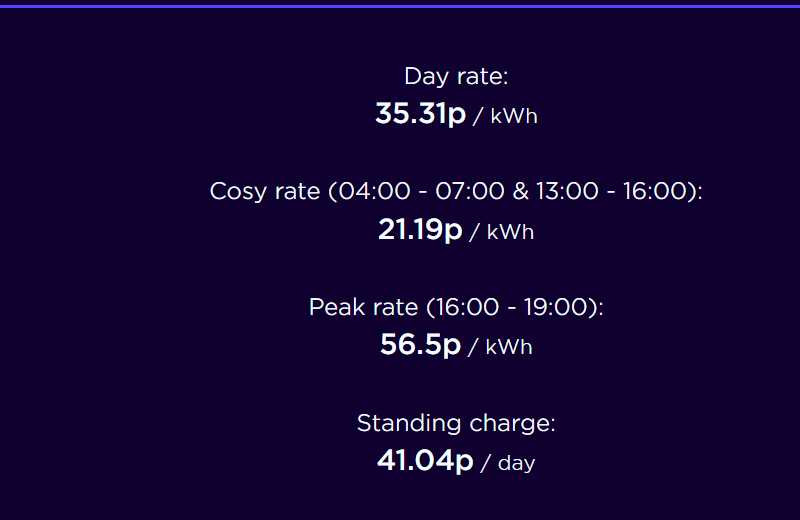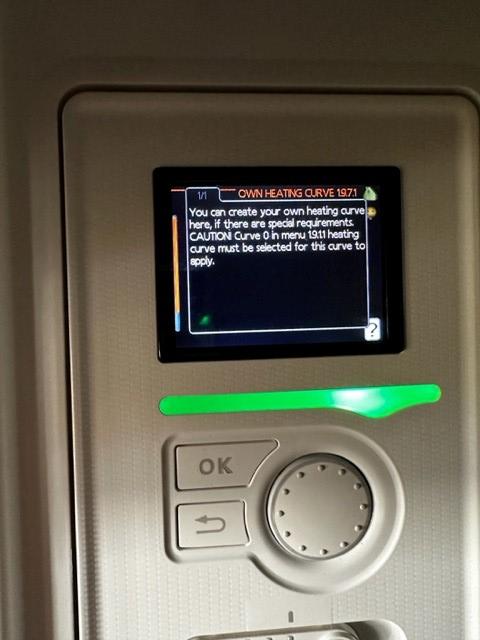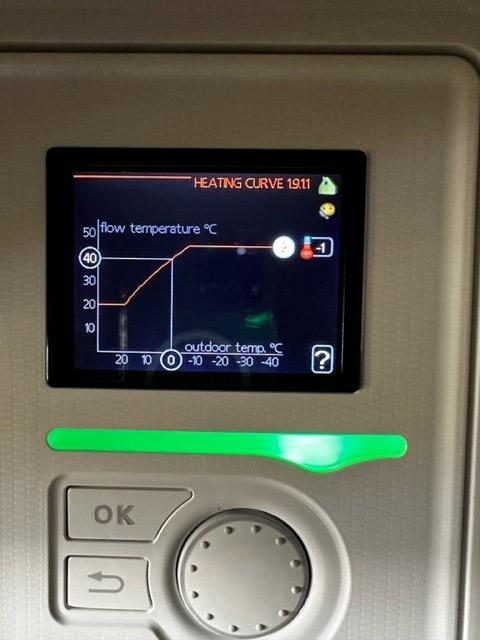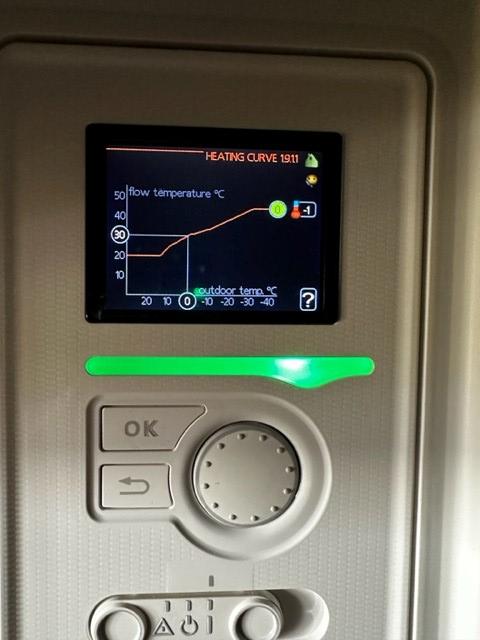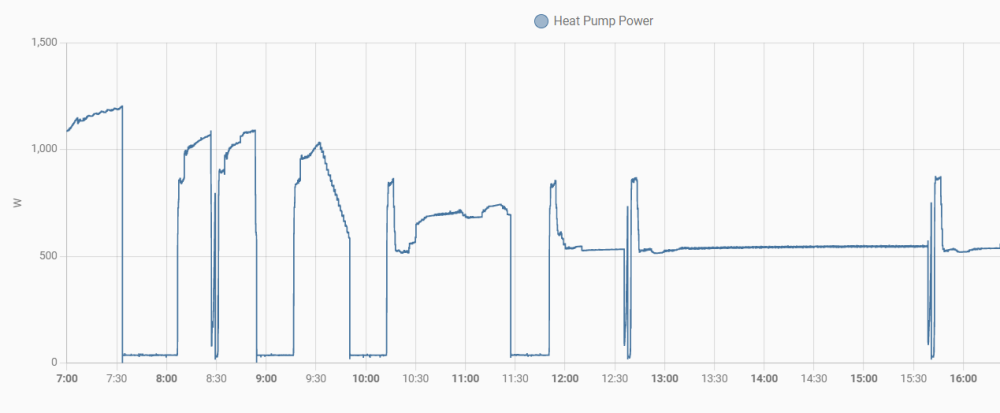
Luke1
Members-
Posts
71 -
Joined
-
Last visited
Everything posted by Luke1
-
OVO which tariff first before heat pump add on
Luke1 replied to connick159's topic in Air Source Heat Pumps (ASHP)
Did you ever go through with and receive your referral bonus from EOn? I had nothing my end and they have requested account details of the account referred to check, I'll let them know it was the 19th December and see what happens. (Not clear if they wanted a name etc, but fully understand if you don't want to ping over to me) -
Heat pump hot water / underfloor heating settings
Luke1 replied to jonm12345's topic in Air Source Heat Pumps (ASHP)
I have the same controller, but have not used the HW smart control, which I think can only be used with solar connected to the system. I would guess that it heats the water when solar is at a peak. I'm not sure if its predictive for weather, and what happens in the case of no solar? I would probably schedule this to the cheap rate period over night. You may be better off doing it this way if you have solar export that is higher than overnight import rates? If you don't run out of hot water in the day, you could also look at tweaking the HW setpoint down to increase COP, likewise up if you do run out and it re-charges in the day when you don't want it to. (This can be accessed in the installer settings by holding the back arrow for 7 seconds from the home screen). In respect of the 24/7 heating, we tend to batch heat over night into the floor slab so that the heat pump doesn't run as much in the day during peak rate electricity. In the shoulder seasons we should be able to heat over night only. I do this by scheduling a temperature increase / curve increase for the overnight period. (Which one you see is dependant on whether you have an internal temp sensor connected to the unit.) -
OVO which tariff first before heat pump add on
Luke1 replied to connick159's topic in Air Source Heat Pumps (ASHP)
Thanks @joth Hopefully the £50 welcome credit will go some way to offsetting the 900% temporary price hike! I do somewhat miss the Octopus API and ease of using their online account, the E.On app is just simply not as good. The extended economy 7 hours are however a win win for me compared with the recent Octopus Agile prices. I have also read a bit about how the latest Tracker formula (for daily rates) is getting worse with each iteration. It makes me wonder if Octopus are trying to force people out of this tariff now and onto more traditional tariffs again. -
OVO which tariff first before heat pump add on
Luke1 replied to connick159's topic in Air Source Heat Pumps (ASHP)
For V4 it was a ‘requirement’ to have either an EV or battery storage. They have just updated to V5 which again states the requirement for an EV but excludes battery storage as they have a new tariff due shortly for that. You have to declare that you have an EV, but they do not check. I think some people had said they were looking into EV ownership and they were still accepted onto the tariff. -
OVO which tariff first before heat pump add on
Luke1 replied to connick159's topic in Air Source Heat Pumps (ASHP)
Having recently moved from Octopus to E.On for exactly the same reasons I only have good things to say so far. My smart meter had stopped communicating with the DCC just before transferring across. E.On booked an engineer to come in a week later who switched it out for a new one. A couple of days later the new readings were coming through onto their website. They agreed to back date the Next Drive tariff from the date I transferred over to them which was a nice surprise too, as I was expecting to pay at their variable tariff rate as per their T&C’s. If you haven’t already started the process, and would like a referral code for £50 off your bill (I would also receive £50) my link is https://share.eonnext.com/topaz-crane-1929 -
No extra accessories were required. I had to access the service menu by holding the back arrow for 7 seconds, and then selected permit cooling.
-
Fan Coil Units for use with a (cooling) ASHP
Luke1 replied to ProDave's topic in Air Source Heat Pumps (ASHP)
Will drop these guys a message. Hopefully they are interested in small domestic customers unlike most FCU companies! -
Fan Coil Units for use with a (cooling) ASHP
Luke1 replied to ProDave's topic in Air Source Heat Pumps (ASHP)
I've come across the I-Life2 Slim 170 on Saturn Sales @ £589 inc. VAT and shipping. Seems they are a UK company and therefore no further customs charges to be paid... https://www.saturnsales.co.uk/I-Life2-Slim-DLMV-170-ATS2-Fan-Assisted-Radiator.html Has anyone found any ducted units in the UK? I have a loft space with suitable space in the eaves where a unit could be positioned and ducting installed. I can't however find any suitable units on the UK market that include drip trays and don't require a bulk order. -
What would you do if you could start your ASHP process again?
Luke1 replied to Bovril's topic in Air Source Heat Pumps (ASHP)
Are you saying there are no HP systems that can intergrate a WB or Aga into the control system? -
You can do this with the NIbe SMO 20 controller. It has a standard temperature / curve setting. It has 3 separate schedules for increasing / decreasing the temperature / curve setting. It has a further 2 schedules for blocking the compressor from working at all.
-
In which case you can definitely set schedules. If you have a room stat connected to SMO 40 you'll be able to set the actual temperature for various periods. If you don't have a room thermostat you can offset the weather compensation curve for different time periods. See page 24 of the user manual https://www.nibe.eu/assets/documents/23958/231765-5.pdf I would highly recommend that you read the other posts on this forum and those at renewableheatinghub.co.uk to understand the importance of running these systems in weather compensation mode and only using your 'Emmetti' thermostat as a maximum temperature limit (which generally is set higher than your required temp ie 24C). Then you tune the weather compensation curve depending on how the house responds to the outside temeprature.
-
I think Nibe S2125 refers to the outdoor unit. What indoor unit do you have that controls your system? Could be an SMO 40 or 20? I have an SMO 20 and I use the scheduling to offset the heat curve at different times. (I increase it over night to make the most of cheap E7 electricity and then set it back during the day)
-
The batteries you linked are twice the price of Pylontech (when adjusted for capacity), but perhaps a small price to pay if they are significantly more likely to have a catastrophic failure. The photos are fairly concerning! I presume you need to complete the G99 Application if you grid tie that inverter? It seems a bit extreme for my requirements given that I'll probably be doing a grid tie system.
-
Thanks for the advice. Looks like they'll be outside on heated pads! I didn't appreciate that there was still a risk with the new LiFePO4 batteries, but as you say, there will still be a significant amount of energy being stored. Seeing as space won't be an issue for storing batteries in an outbuilding, is there better bang for your buck by getting an older design of battery?
-
Interesting, I think what you're describing makes sense. I should be able to insulate the shed portion fairly well to, so perhaps that will negate some of the winter losses. My plan is also to split my solar across the shed & log store at 35 degree slope and also a future pergola where I will either have them flat or perhaps tilted South slightly, but the gain doesn't seem huge by raising them 10 degrees or so, and I don't really want to see them poking up from the pergola. I've been looking at the voltacon website for budgeting purposes as it gives you customisable sizes and then I just need to account for the electrician, cable etc. https://voltaconsolar.com/solis-hybrid-5kw-pylontech-us2000-system.html Good Idea on the AC back to the house. I have a 50mm duct going in as we speak, so it's probably worth running 2 cables through it. One for the grid tied side and another with the backup power.
-
I'm working out how best to build a PV and battery storage system. Log store & shed (not insulated) approx 25m from the main house. PV Panels to be installed to log store & shed - 12 x 400W panels. Battery storage to be added sometime in the near future. Ideally I think I'd like the batteries to be inside the house as I understand they don't operate particularly well below 0C (I'm thinking of the lithium Pylontech batteries) The inverter and batteries can go in the loft space of the house, or in the log store. Would it be best to keep the DC run short and have the inverter in the shed and batteries in the shed. Or could I run the DC cables back to the house, or would the losses / cable need to be too big? Or do I use a separate inverter for the PV panels and the batteries? (Will this cause me potential control issues?)
-
If I remember correctly you have a NIBE? I have recently found you can adjust the compressor frequency curve compared with outdoor temperature separately for heating, hot water and cooling. Perhaps you could utilise this to slow down the heat pump if you want to use excess PV via the HP? There is also a module and settings I believe that can optimise the HP based on current solar generation.
-
Octopus Cosy - new tariff for ASHP owners
Luke1 replied to George's topic in Air Source Heat Pumps (ASHP)
Do you know what the 5kW model can modulate down to? I can't see the 2.5kW model modulating down much more. And for piece of mind, especially with recent posts regarding cold snaps and constant defrost cycles then I would something slightly larger that necessarily required. For info my Nibe 8kW heat pump has a max draw of 4.0kW, and at its lowest setting it draws a little less than 500W. All you need to do is match your output of UFH and radiators to maxmise what heat can be extracted from the system and ensure this matches or exceeds the lowest output from the heat pump. (It would only then 'cycle' when the house has reached temperature) I'm sure someone more technical could explain that better. -
Octopus Cosy - new tariff for ASHP owners
Luke1 replied to George's topic in Air Source Heat Pumps (ASHP)
In my area the peak is quite high. (Note this is a flexible tariff and so it will go up when the price cap changes!) Unfortunately I can't see this working for most people that cook during the peak. Made worse by the fact that for approximately 6 months of the year you won't really be benefiting at all from the 'cosy rate' as you wont need heating. My fix ends at the end of January so I'm trying to find other deals and suppliers that may work better for me. EDF have a E7 flexible tariff which is currently 0.07p/kWh night and 0.055p/kWh day. Which actually works better for me than the Cosy deal. I have also worked out that I could possibly 'save' ~£1000/year if I installed a 9kWh battery based on those rates. ROI approx 6 years at today's rates. However with the market being so unstable it's a big risk to know whether the E7 rates will always be this low in the cheap hours, especially with ever increasing EV charging on the grid. -
I don't think you can design oversized UFH. The higher performing UFH the better because it will allow you to run a lower flow temperature from the heat pump. Your heat pump will be able to heat water to whatever lower limit you require. This makes no difference if its a 5kW unit or a 12kW unit. My heat curve starts providing water at 21C. Yes it cycles, but it cycles so infrequently that it's not an efficiency problem.
-
Which controller do you have? Is this an SMO 020? Its odd that you have it running in 'own curve' setting (checking mine it appears these are the exact same defaults that I have) I however use the actual graphical curve instead. If you go to heating -> advanced -> curve can you see if you're actually using the own heating curve or the actual curve. This is my current curve: It tells you to set the curve to 0 to use the own curve setting This is what the standard default 'own curve' looks like when you select 0 next to the little thermometer icon.
-
It was probably for heating. The Nibe system works on 'degree minutes' therefore whilst the curve may say flow at 0C of 32C the heat pump will run until any deficit of degree minutes is brought back to 0. My heat pump is set to start running at -60DM and in the first few minutes whilst flow temp is lower than the curve it will increase to say -80DM, and then it will lose these for every minute it spends above the curve temp. So if the heat pump is providing water at 42C compared to a curve of 32C it will lose 10DM every minute. Then when it hits 0 it will turn off. This whole situation gets worse when it has to defrost or carry out DHW heating. Frustratingly whilst the heat pump can modulate down, it doesn't seem to get close to the curve and modulate down so that the DM stays stable. My compressor in auto mode appears to run much higher, but for a shorter duration then cut out for a while. I have manually adjusted my compressor curve (in installer settings) to modulate down so it takes longer to catch up the degree minutes, but runs for a much longer duration. I don't have any evidence yet as to which way is more efficient. I suspect the latter may be more efficient as the system doesn't appear to frost up as quickly. The first graph shows the system running with the auto curve in an on / off fashion. The second graph shows the heat pump running at half the power but over a much longer duration.
-
Can you go into indoor climate -> advanced -> curve and send a picture of the heating curve you have?
-
I've got a Nibe controller, so if you have any specific controller settings then I can help answer. Unless the curve has been set to flat line the default system should be set up for Weather Compensation. If you could take a look at this and provide a picture or details requested above then that would be a good start to getting some answers. (Do you have Nibe Uplink so that you can monitor / control the system remotely?)
-
My Nibe SMO 20 controller has the functionality to do this. I can schedule either a change in the room temperature, or an offset to the curve for up to 3 schedules. So in essence 4 schedules if you include the standard WC curve setting. (And this can be different on each day if you really want!) I have been using this to ramp up the flow temperatures over night whilst I have cheap 5p/kWh electricity! It can also integrate PV information, and offset the heat pump curves in similar ways I believe, however I've not looked into this because I don't have PV yet... The Nibe controls sound significantly better than many of the controls on other heat pumps on this forum. Yet no one generally considers controls when purchasing a unit.



